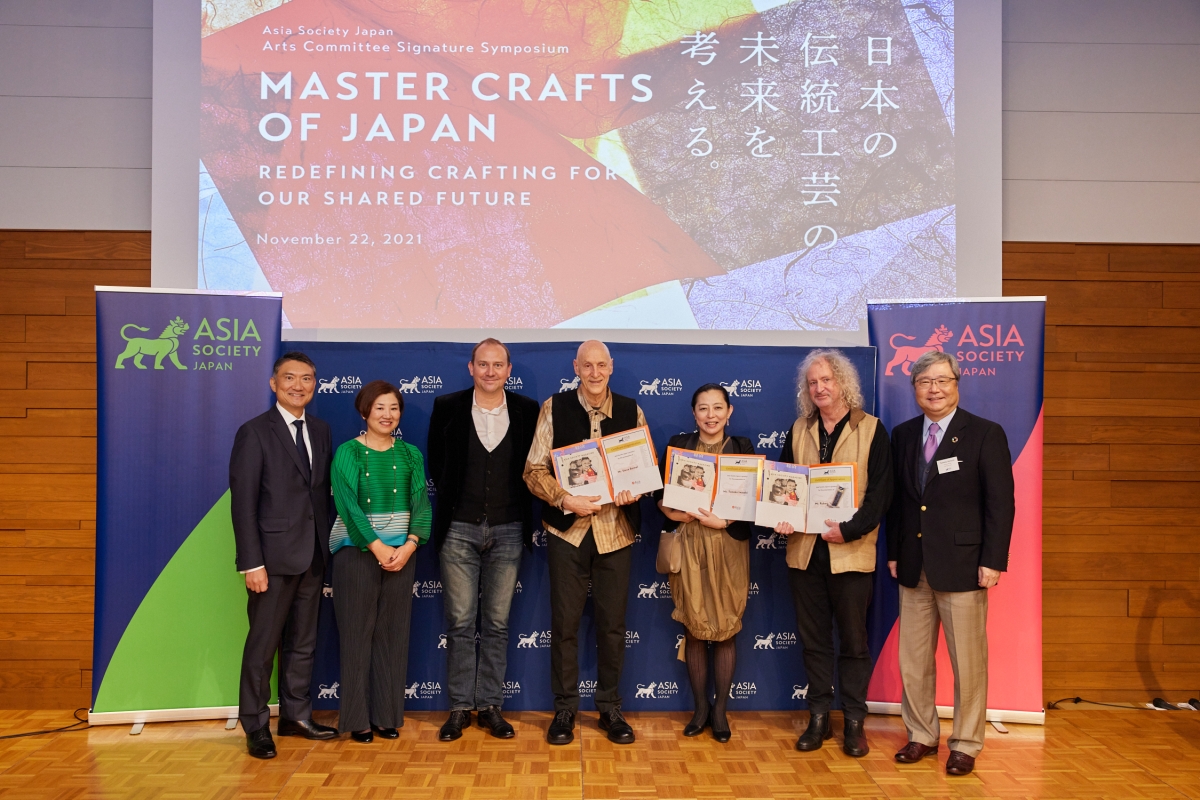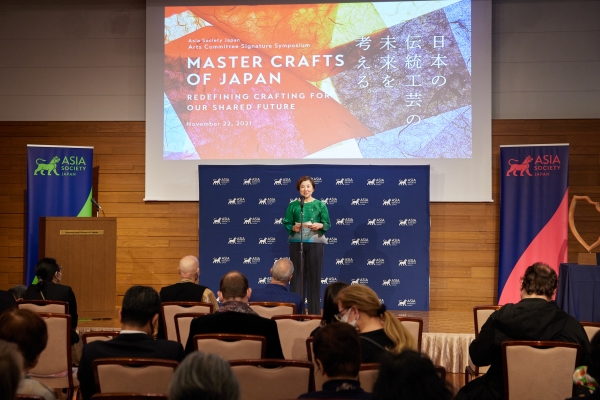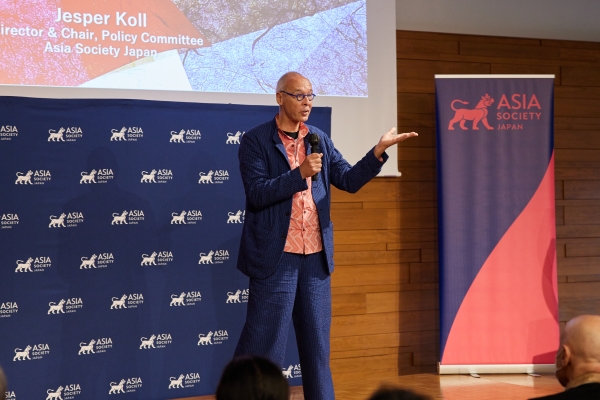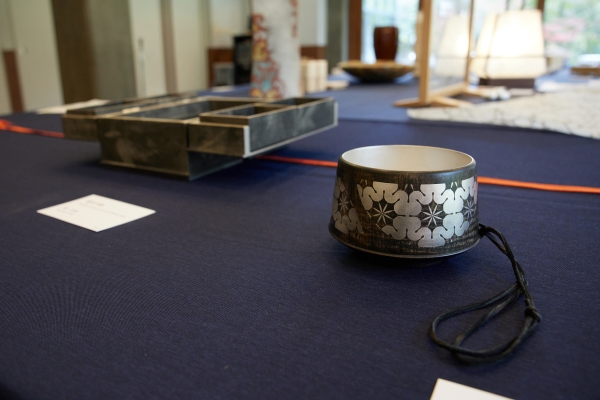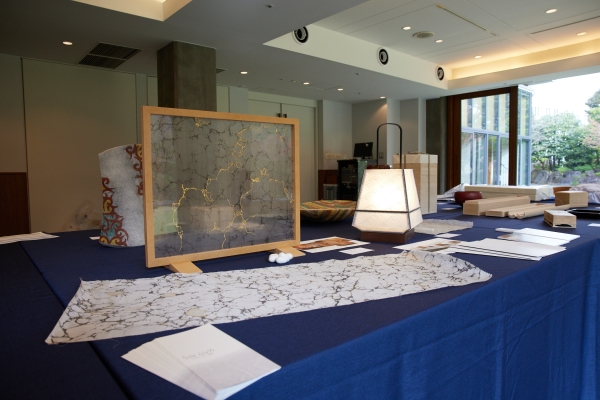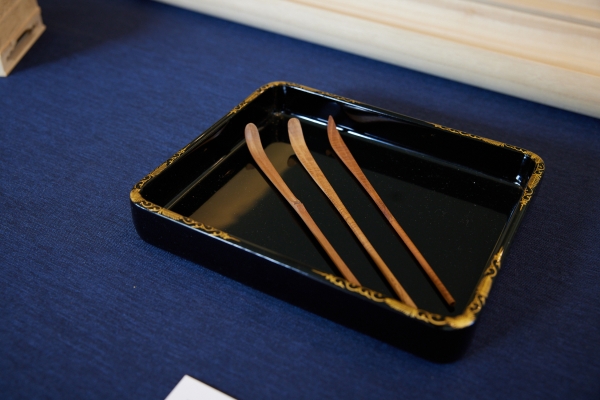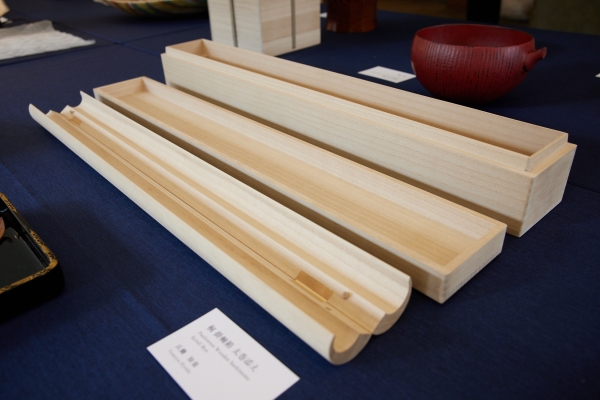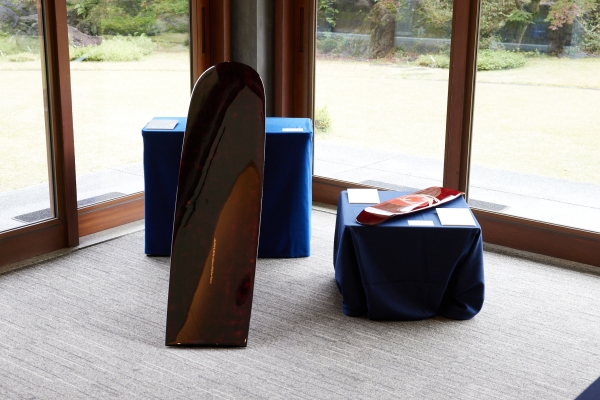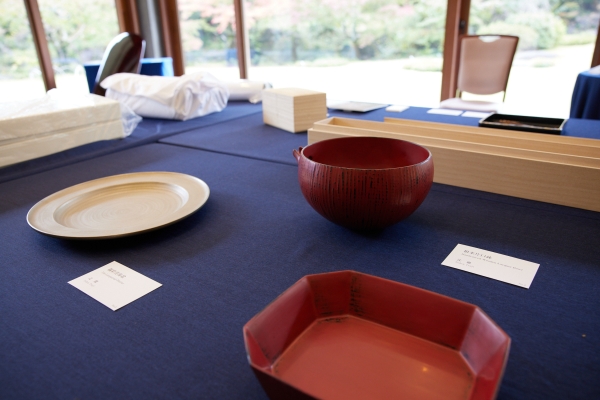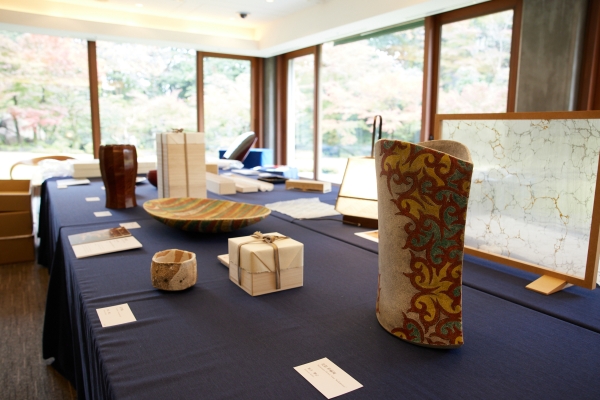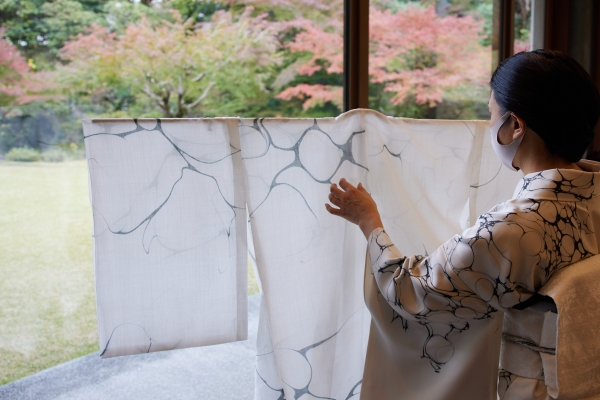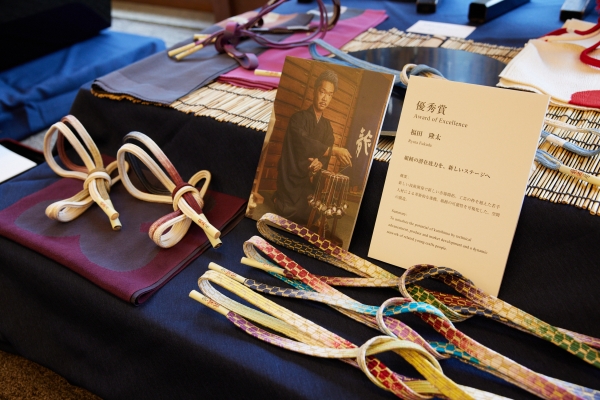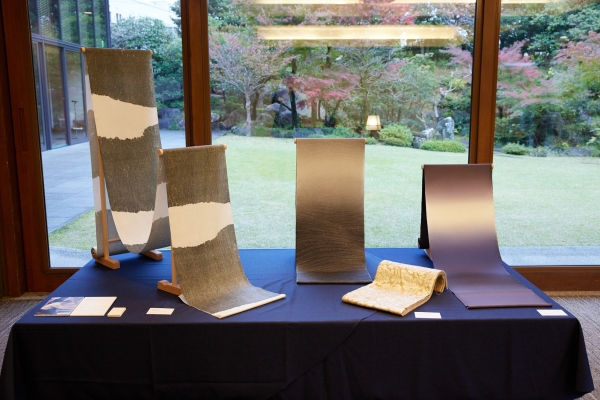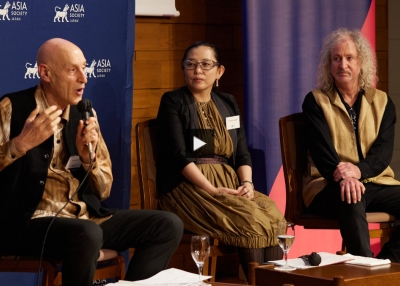Master Crafts of Japan: Redefining Crafting for Our Shared Future (Recap)
In Part 1, Mr. Robert Yellin gave his keynote speech on “Contemporary Japanese Ceramic Art: Shifts in Overseas Perceptions and Collections.” This was followed by a coffee break, during which the audience was invited to see works of the JapanCraft21 finalists on display in the next room. Part 2 began with comments from Mr. Steve Beimel on what had inspired him to create the JapanCraft21 initiative and his prospects for the next five years. Then, Ms. Tomoko Iwaseki offered her comments on Creations of Japan’s plans for the next three years and the potential for commercial involvement. The three speakers engaged in a panel discussion with the moderator, Mr. Tsutomu Horiuchi, on the wording of “master crafts,” the distinction between Kogei and art, and motivating young people to join the world of traditional crafts. A brief Q&A session covered several follow-up questions on the comments made by each speaker.
Part 1: Keynote Speech
“Contemporary Japanese Ceramic Art: Shifts in Overseas Perceptions and Collections” by Mr. Robert Yellin
Starting his journey from a 390-yen guinomi
Mr. Yellin’s first guinomi was a 390-yen sake cup that he bought at a local supermarket in Numazu. As a young man looking for meaning in life, he had been inspired by Eastern spirituality and philosophy, where a person’s identity comes from within. He came to Japan to study poetry but was enchanted by pottery, which he found to be “handheld poetry.” Both poetry and pottery were the essences of the material.
Mr. Yellin started his journey as a novice in the world of Japanese ceramic art and worked his way up the ladder of knowledge. He says, with humor, that he has paid a lot of tuition along the way — sometimes being deceived into purchasing gansaku or fake pieces. It took him many years to adjust his eye from the Western Renaissance aesthetics that he was brought up to appreciate, to Japanese aesthetics, where beauty is not linked to symmetry.
After compiling a tremendous amount of knowledge about Japanese ceramic art through reading, visiting kilns, and most importantly, living with and using Japanese ceramics, he found that any information readily available to foreigners was focused on Mashiko-yaki, whose kilns are relatively new in the history of Japanese ceramic art. Foreign people were only informed of Hamada Shoji and Shimaoka Tatsuzo, ambassadors of Japanese ceramics who were able to reach wider audiences through their friendship with Bernard Leach. However, Mr. Yellin felt that the overseas audience needed to know more. By the introduction of his good friend and sake evangelist John Gauntner, he started a column in the Japan Times called Ceramic Scene which would continue for ten years. Furthermore, in the 1990s at the outset of the Internet era, Mr. Yellin launched a website to introduce and sell pieces to clients around the world.
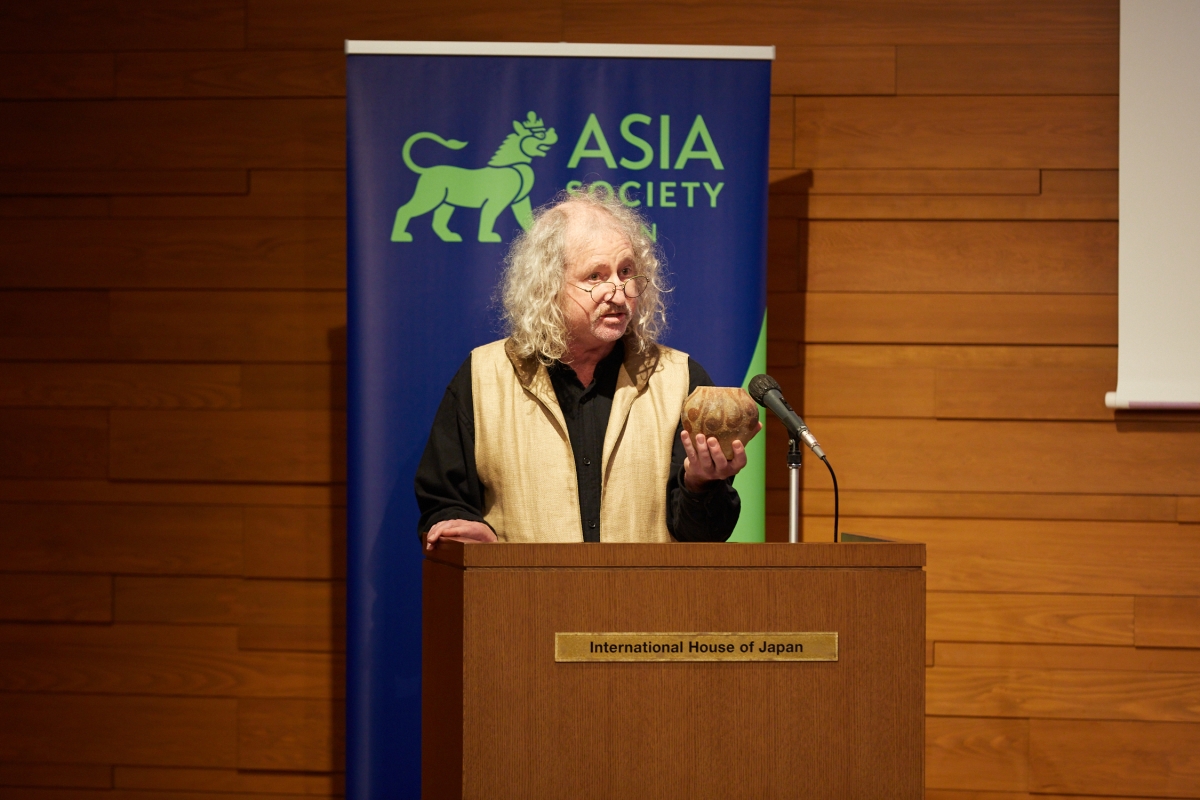
The beauty of Japanese yakimono
In his gallery, Mr. Yellin shows a balance of old forms along with purely original ones. The materials used to make a pot — clay, water, fire, and air — are the basic elements of life itself. These ingredients have not changed much since the first pots were made in the Jomon period. Pieces from the past continue to move people in modern times, and likewise, what we use today will be appreciated in the future. He has been fascinated by the metaphors about letting go of total control and seeing what happens in the kiln or seeing what happens in life.
One must look at art with one’s heart. This is why at Mr. Yellin’s gallery, nothing is labeled. Everyone should have a favorite yunomi at one’s side that allows one to find oneself in the beauty of the present moment.
Overseas markets for Japanese ceramic art
Mr. Yellin’s clients are from around the world. Some purchase works for daily life and others purchase works solely for display. Today, more collectors are acquiring works that can be shown in museums. When Mr. Yellin started collecting in the 1980s there were very few museums interested in contemporary Japanese ceramic art. The first gamechanger was an exhibition covering ancient to contemporary Japanese ceramics curated by Koyama Fujio at the Seattle Museum back in 1961.
Tradition is a living thing and if it does not have relevance to our lives today, it either impedes growth on a physical and/or spiritual plane or simply disappears. Today, ancient styles are being brought up to fit the needs of today. Many artists are looking to the overseas market to make larger works specifically for showing at galleries. A collector will often purchase work and then donate it to a museum or have it shown at a museum after creating a substantial collection over time. Mr. Yellin hopes that with the popularity of these works overseas, the Japanese populace will return, realizing the beauty that they possess but are critically on the verge of losing.
Starting from the home
For that resurgence to happen, it has to start at home for younger kids, with parents showing the enduring value of handmade works. We need to retain value on many levels — culturally, economically, spiritually, and environmentally — over the years. Mr. Yellin was once told by a Zen monk that environmental problems are not outside us, yet start within us; and he adds that they quite often begin in the kitchen, or how we live and how we live with the things we purchase, which is a reflection of our values. Recovery also needs to start with regional assistance for areas that are defined by the crafts made there for centuries. Once we can get crafted works into people’s daily life, people will realize through use their value, which cannot always be measured with money.
Overseas market trends
Mr. Yellin’s overseas clients wish to see traditions being upheld and those who have visited Japan and gone to these ceramic towns always return home changed in their appreciation of Japanese culture. However, with online auctions and the chance of a bargain, many collectors are unfortunately currently searching for works through the secondary market. If this trend does not change, quite a number of kilns will disappear. There are more auction houses overseas offering contemporary Japanese ceramics, which for living artists also props up their name value domestically.
In closing, Mr. Yellin encouraged the audience to open up their wallets and live with something of which they actually have met the creator. He invited the virtual audience from overseas to support their local crafts.
Part 2: Panel Discussion
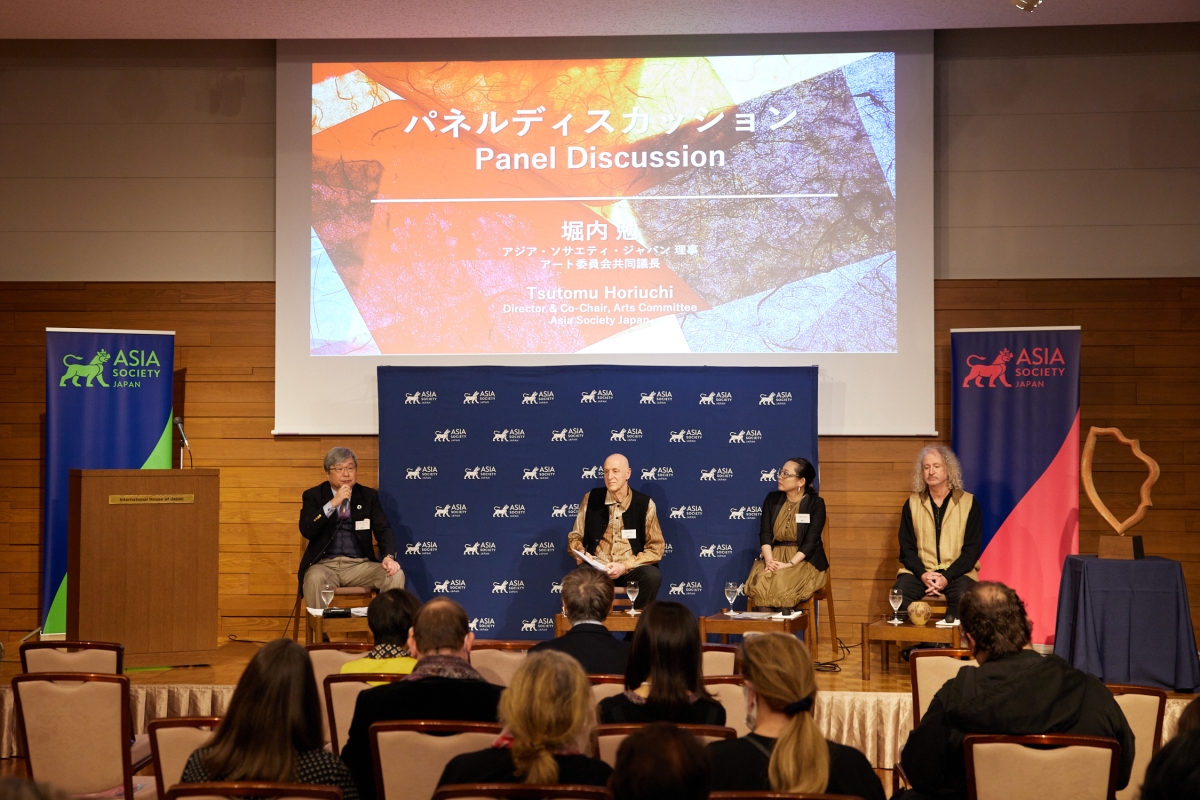
Initial comments from Mr. Steve Beimel
What gave you the idea of the JapanCraft21 initiative and how do you expect it to expand in the next five years?
Having watched master crafts disappear over the last 50 years in Japan, Mr. Beimel created JapanCraft21 three years ago to identify viable but vulnerable Japanese crafts and their pressing needs, and to assist them in flourishing in the 21st century. JapanCraft21 is a volunteer group self-funded by their membership comprising both non-Japanese and Japanese craft lovers. Its two main projects are a weekend school teaching traditional Japanese building skills and a series of Japan Traditional Craft Revitalization Contests.
Western appreciation of Japanese master crafts
In the late 1800s, the Japonisme craze swept Europe, exposing for the first time to the outstanding quality and beauty of Japanese master crafts. Kimono inspired Western fashion from the 1870s. In the 1980s Japanese influence resurfaced with a fashion revolution in Paris inspired by designers who introduced unstructured, asymmetrical clothes that wrapped instead of being cut and sewn.
In the mid-20th century, Japanese joinery and gardens influenced U.S. architecture. Japanese shoin and sukiya-style architecture inspired Bauhaus and minimalism. Japan later became a ceramics Mecca. Japan’s influence ranged from Zen and Zen aesthetics to Japanese cuisine and food presentation.
Why are master crafts disappearing and why save them?
However, the actively employed master craftspeople population has decreased by about 80% since 1979. Most masters are now getting ready to retire or have passed retirement age and few young people are taking over. The toolmakers and suppliers supporting crafts are also disappearing, thus devastating the interdependent ecosystem in the craft community.
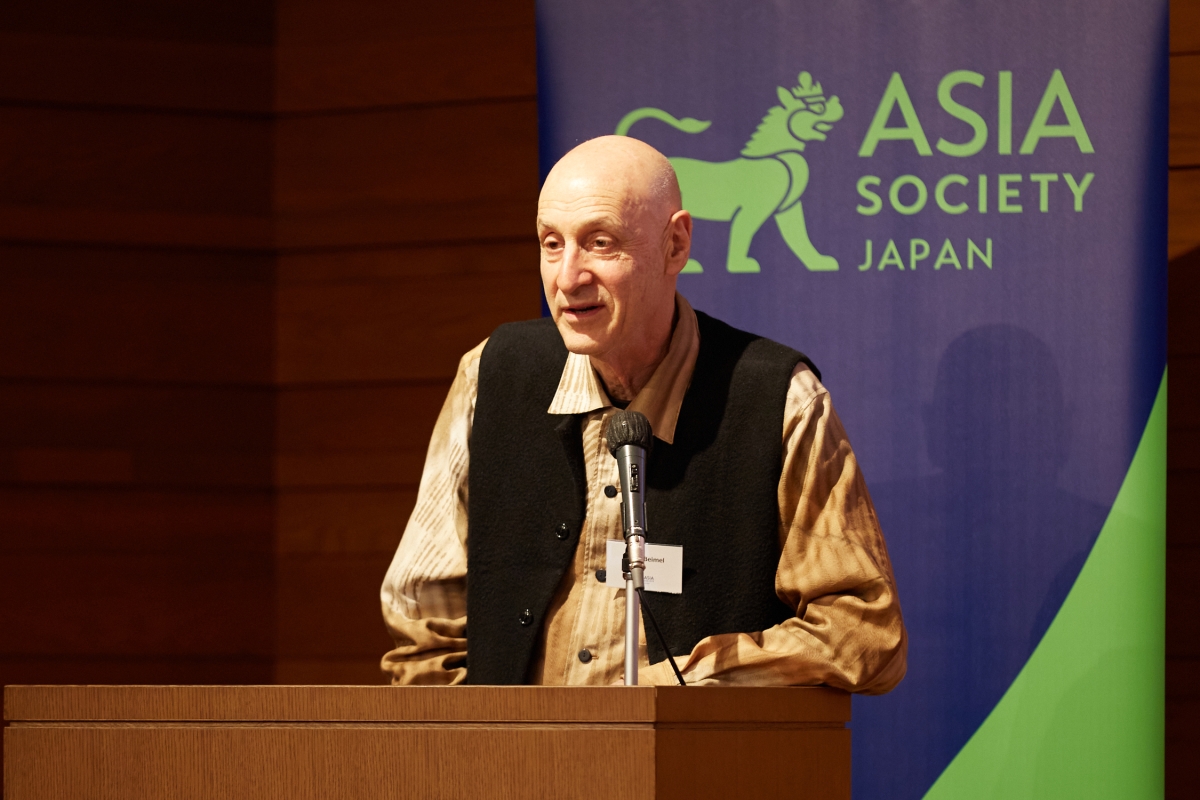
The disappearance of multi-generational families, where grandchildren were taught by their grandparents has greatly affected the public understanding of traditional culture. Few people see the difference in the quality between an inexpensive item produced offshore in a factory by unskilled workers and locally produced by hand by a craftsperson.
Changes in the business community have also contributed to diminishing crafts. The tea mentors and patrons of the Meiji, Taisho, and early Showa periods were often corporate leaders who studied the art of tea and maintained tea collections. From the 1970s golf replaced their pastime. The corporate PR budget has also eroded traditional culture. The Buddhist establishment cannot compete with the funeral industry; decreased family membership has led to less demand for Buddhist-related crafts involving metalworking and fittings, woodworking, lacquer, and textiles. Corporate residential construction has eliminated the tokonoma, a traditional showplace for ceramics and art.
Japanese “master crafts” are based on knowledge and precision skills honed over centuries. Each master craft is created by way of a unique collaboration that permeates the culture. They are ecologically sustainable and enhance our lives. They encourage mindful living, give meaningful work to young people, and connect us with nature. The Japanese way of “i-shoku-ju” (clothing food and dwelling) is a powerful remedy to the global trend of mindless consumerism and addiction to devices.
Recent developments of JapanCraft21
JapanCraft21’s weekend school offers fully-funded scholarships for young working carpenters in Kyoto, giving them a pathway to true mastership. Last year it graduated their first class of six young carpenters who are capable of building a wooden house entirely without nails. This spring they enrolled five young plasterers in a Japanese bamboo mud wall construction course. This winter they will begin a course for young working gardeners.
In 2021, JapanCraft21 hosted the first Japan Traditional Craft Revitalization Contest. The contest allows the contestants to reveal the problem and how they can be supported. Each contest selects an exceptional individual with an outstanding idea to revive a traditional Japanese craft to flourish in the 21st century, talent, track record, and passion. Opening their doors to applicants in February 2021, they received 154 applications. The winning strategy seeks to create a rural ecosystem, planting trees, creating a craft community, educating people, and launching a business for eco-friendly lacquer surfboards that are more durable and fun to maneuver. They have been provided with five million yen and mentors to support them. Another five million yen has been allocated to the other finalists to build peer support and create a platform highlighting the skills of our winners.
The ten finalists are now members of the Craft Leaders Council. They have just begun to work together, sharing their ideas, networks and work to develop new products and markets. Each annual contest will add ten new members to this group. The ten leaders have also been asked to produce a special craft work over the next few months that will clearly display their skills and potential. Sometime in Spring 2022, these works will be presented on an online platform to be shared with gallery owners, designers, architects, and major collectors around the world.
In conclusion, Mr. Beimel invited the audience to join their initiative to take meaningful, important, immediate action to identify problems and adopt viable strategies not only for their survival of beautiful crafts but to see them flourish through the 21at century.
Initial comments from Ms. Tomoko Iwaseki
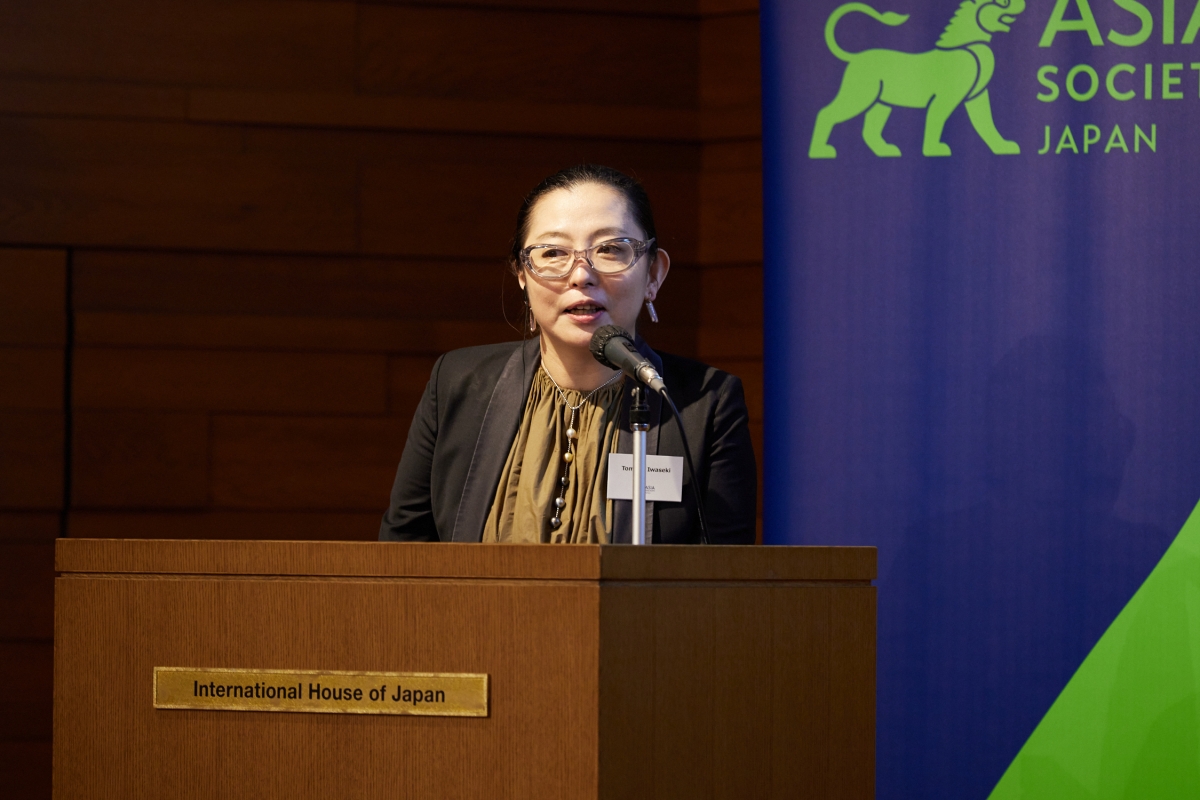
Please tell us more about your plans for the next three years and if there is a commercial element planned for the future.
Creations of Japan looks at the language used to communicate crafts and seeks to create avenues of information. The organization explores how we can recapture the use of crafts in our everyday lives. They are currently in the process of forging networks, connecting the different dots across Japan.
We still live in times when we can find crafts somewhere in Japan if we try hard enough to locate them. We will probably still be able to discover crafts around us in the next five to ten years. We have young people who have not necessarily been educated in identifying master crafts but know by instinct. We also have non-Japanese people like Mr. Yellin and Mr. Beimel, who appreciate these works. Yet, we stand at a critical point of finding out how to transmit this knowledge to future generations. The fact that the materials and tools are disappearing makes the problem even more crucial.
People have different definitions of crafts. This diversity is powerful and yet a weakness in preserving Japanese crafts. The Japanese silo mentality prevails in the way the government and local governments preserve their local crafts. Crafts that do not fall under their boundaries both geographically and in terms of how they have defined crafts in their policies and laws fail to be preserved.
Creating a transdisciplinary platform and translation guidelines
Creations of Japan has created a transdisciplinary platform connecting Tokyo, Kyoto, and Kanazawa connecting craftspeople instead of leaving them in rivalry.
The organization has also compiled Kogei Translation Guidelines. Translated descriptions of Kogei works often make no sense to the audience. The vagueness of the definitions themselves was also an issue, as they have not been reviewed for a long time. In Kanazawa, Creations of Japan produced guidelines by identifying the different ways words and concepts were being translated and talking with craftspeople to understand how they used them. They have also included how some words should not be translated.
Kogei Picnics
Kogei Picnics is an initiative that held its first event in Kanazawa with the support of the Tokyo Picnic Club, a group of artists conducting picnics as art events. People bring their own craft pieces and food to a Kogei Picnic, and in the spirit of the social event, they are not to complain if a piece is broken at the venue. Mitsubishi Real Estate has been supportive of this initiative. Creations of Japan seeks to hold this event across the world and is currently engaged in discussions with the French, German and Italian embassies to organize international cultural exchange events in their gardens.
Creations of Japan will spend the next two years finishing up on building connections across Japan. Their next step will be to explore digital transformation to facilitate the physical transport of objects to other countries. They will explore dynamic efforts to reach out to overseas audiences and markets.
Discussion
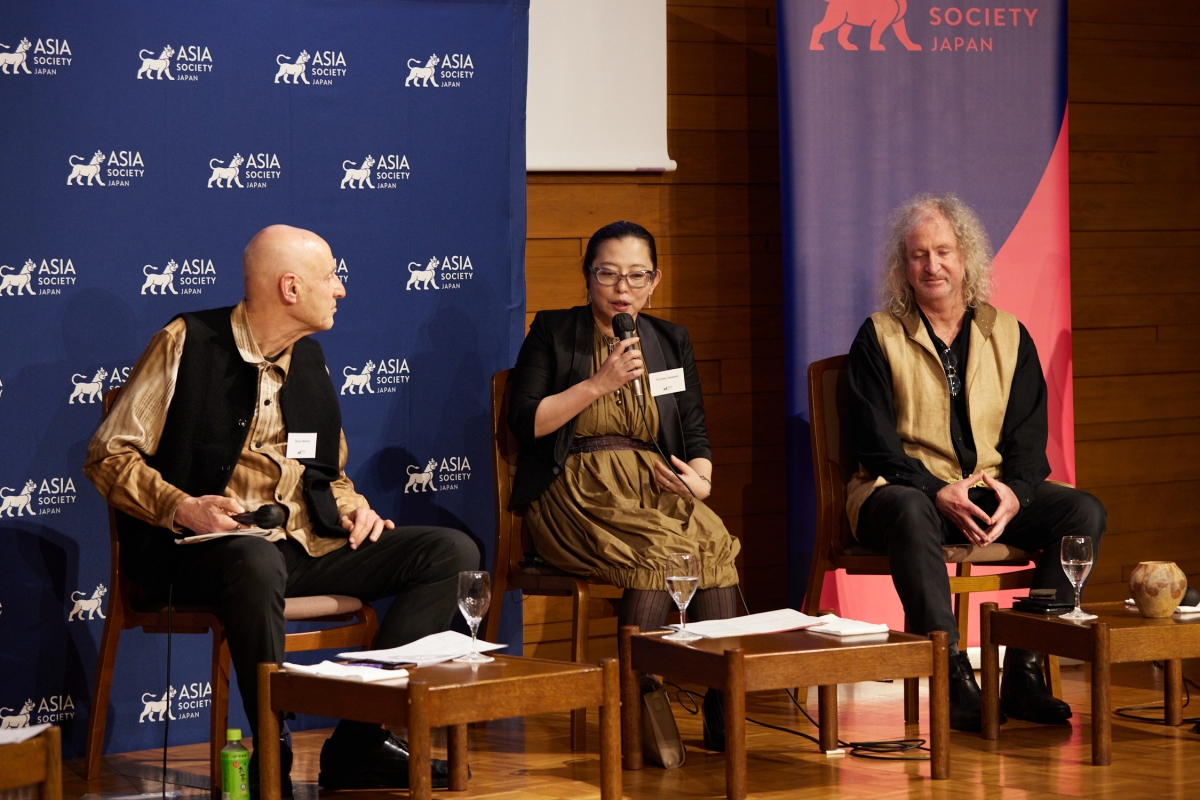
Who is buying Japanese crafts today? What are the differences in the way Japanese and overseas customers purchase Japanese crafts? What can we do to increase purchases from overseas collectors?
Mr. Yellin noted that overseas collectors tend not to care as much as Japanese buyers about the pedigree of the craftsman. They trust their senses and look at works without peripheral knowledge. People need more exposure to Kogei. For people who do not possess background knowledge, he advises them to see more works to learn more about one’s own preferences and to live with the works. Mr. Yellin advises the Japanese government to open a Kogei salon in major cities around the world to bring the crafts into people’s homes and lives, just as each prefecture displays local products in satellite shops in Tokyo.
What are the different nuances of “master crafts”, handcrafts and Kogei?
Ms. Iwaseki recalled that at their initial meeting for this symposium, she was uncomfortable with the original title “Handmade crafts of Japan” and that Mr. Beimel suggested that it be changed to “master crafts.” Mr. Beimel explained that the word “crafts” can refer to a wide variety of items while Kogei refers to crafts made by someone who has honed his skills in many years of apprenticeship and practice and should be distinguished from other crafts. Yet, while some people prefer to use the word Kogei, the term makes little sense to Westerners.
Mr. Yellin commented that he named his gallery “Yakimono Gallery” with the intention of introducing the Japanese word for ceramics and bringing the word into the English lexicon.
Ms. Iwaseki pointed out that “master” craft gives the impression that the works are one-of-a-kind. However, reproducibility is a virtue of Kogei. Asked by Ms. Iwaseki if “authentic crafts” would be an acceptable term, Mr. Beimel responded that while the term was straightforward, it would also be unintentionally insinuating that the other works were not authentic. It would be better to identify a “master” craft simply by the training that the craftsmen have received.
Later, a comment from the audience suggested saying “artisan crafts” instead of using a masculine term. This would also reintroduce the art aspect.
What is the difference between Kogei and art? Does the difference have any relation to the reason why Kogei is disappearing?
Referring to a conversation that she had with Mr. Nakagawa Shuji, a woodworks artist famous for his wooden buckets, Ms. Iwaseki said that she was told that “art was consumed.” Art collectors tended to prefer limited editions and unique works. Mr. Nakagawa wished to communicate to the world that Kogei should be purchased with a different mindset — an appreciation of skills, material, and sustainability. Ms. Iwaseki commented that the price value of a Kogei work may be dependent on how it is marketed.
Mr. Yellin pointed out that a re-evaluation of ceramics, which have always been given little recognition as a form of art, is occurring with their recent inclusion at galleries and museums around the world.
What motivates young people to enter the world of traditional crafts? What kind of support can the government and businesses provide to encourage people to join and stay in traditional crafts?
Mr. Beimel pointed out that five of the 10 finalists in the JapanCraft21 contest were following family traditions and the other five were newcomers. Many young people are attracted by the spirit of the craftsperson. We need the master craftspeople to be teachers, as they are the people who recognize talent when they see it. However, the master craftspeople have no market and are thus currently taking fewer or no apprentices. The government could offer stipends for those learning crafts and honorariums for the masters. Business is the ideal venue for product and market development. The three parties need to work in collaboration.
